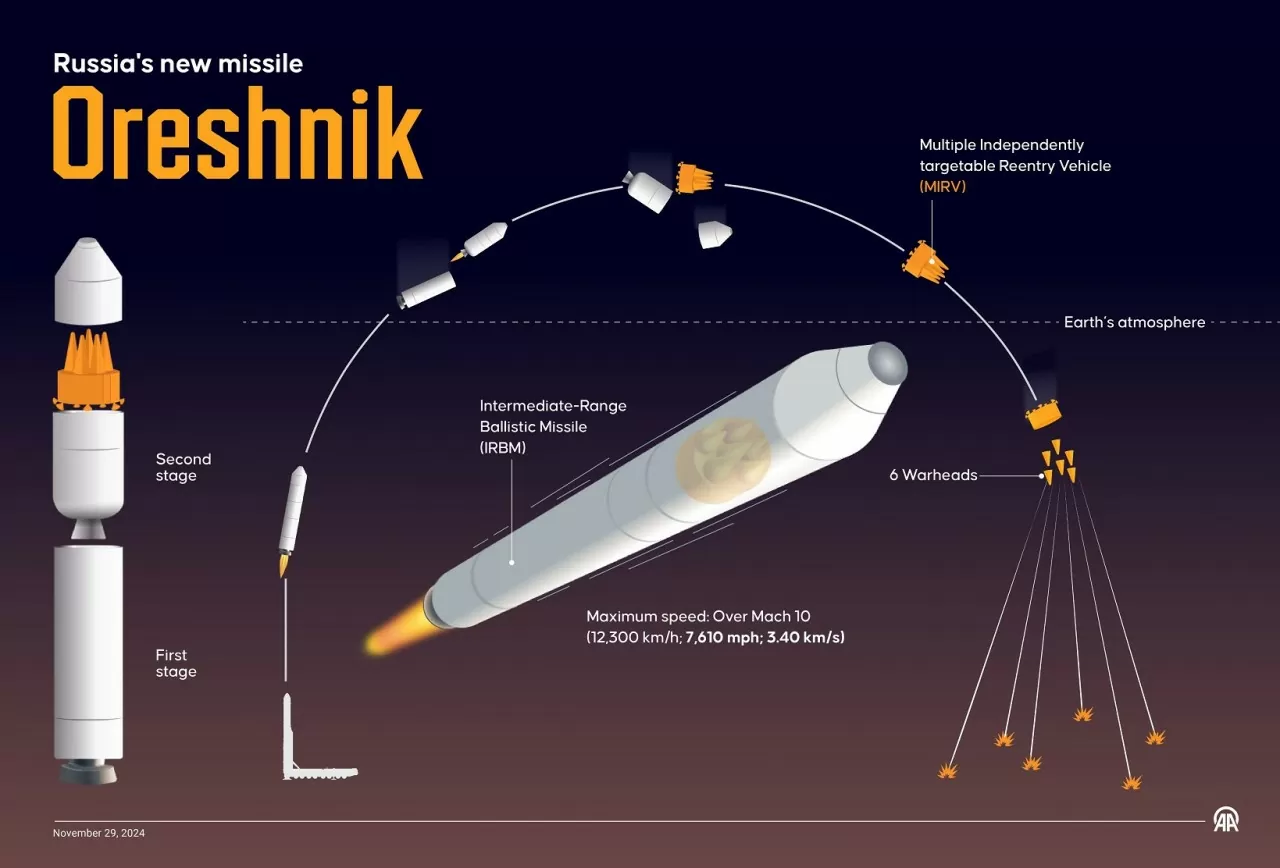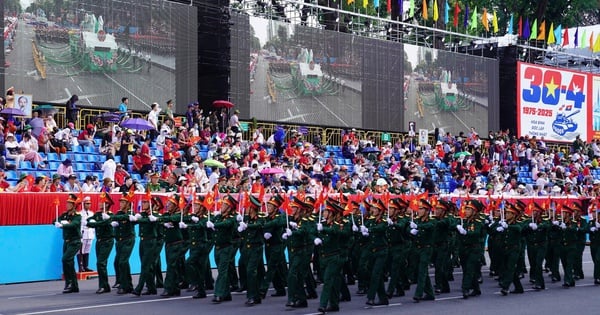Russian President Vladimir Putin said Moscow will continue testing the Oreshnik hypersonic ballistic missile in combat conditions after its first test in the conflict with Ukraine.
 |
| The Oreshnik missile has a speed of 10 times the speed of sound and many outstanding capabilities. (Source: Reddit) |
Putin's statement came after Russia used an Oreshnik missile to attack Ukrainian territory on November 21. The Russian president added that the country will continue testing the Oreshnik missile system and mass-produce new missile systems.
In addition, President Putin also affirmed that currently in the world there is no weapon that can intercept this type of missile.
As for the Oreshnik missile, it is a completely new medium-range ballistic missile capable of carrying a nuclear warhead that has never been mentioned before in public. The Oreshnik missile, which Russia used in the attack on the city of Dnipro (Ukraine), tested in combat conditions "one of Russia's newest medium-range missile systems". According to the Russian President, this attack was a successful test of the Oreshnik non-nuclear hypersonic configuration weapon and achieved the set goals.
Rocket engineers named the missile Oreshnik, or cedar in Russian.
Supersonic speed
The Oreshnik unstoppable air defense system is a missile that attacks at a speed of Mach 10 (10 times the speed of sound), or 2.5-3 km/s.
The Oreshnik hypersonic missile travels at a minimum speed of Mach 5 (five times the speed of sound) and can maneuver mid-flight, making it harder to track and intercept.
"Modern air defense systems... cannot intercept such missiles. It is impossible. So far there are no means of countering such weapons," Mr. Putin said.
Ukraine's Main Military Intelligence Directorate (GUR) wrote on Telegram that the Oreshnik missile took just 15 minutes to fly from the Kapustin Yar test range in the Astrakhan region to the city of Dnipro, a distance of about 800 km (490 miles), reaching a terminal speed of over Mach 11.
Warhead
According to Russian military expert Viktor Baranets, the Oreshnik missile can have from 3 to 6 warheads. Meanwhile, the Main Directorate of Military Intelligence of Ukraine said this type of missile has 6 warheads.
Igor Korotchenko, editor of the Moscow-based National Defense magazine, told TASS that based on video footage of the attack, the Oreshnik had multiple independently guided warheads. According to military experts, the Oreshnik carried conventional warheads in this attack, but it could also be nuclear.
"The fact that the warheads reach their targets almost simultaneously" shows that the system is "very effective," Korotchenko analyzed, calling it "a masterpiece of modern Russian solid-fuel military missile technology."
Range
As described by President Putin, the Oreshnik missile is a medium-range ballistic missile (MRBM), but according to Russian military experts, the correct term should be intermediate-range ballistic missile (IRBM). Intermediate-range ballistic missiles have a range of 1,000 to 5,500 km, second only to the range of intercontinental ballistic missiles (ICBMs).
Military expert Ilya Kramnik claims that the Oreshnik's range could be at the upper end of the intermediate-range missile spectrum, around 3,000 to 5,000 kilometers. Meanwhile, Dmitry Kornev, editor of the Military Russia website, said that this is the first time in history that Russia has used intermediate-range ballistic missiles in combat.
Source
The US Department of Defense describes the Oreshnik as an “experimental” missile based on Russia’s RS-26 Rubezh intercontinental ballistic missile (ICBM). Information about the Rubezh, an improved version of the Topol ICBM, is scant.
TASS news agency quoted a source as saying that in 2018 the development of Rubezh was frozen under the state armament program until 2027, in order to give priority to another system, Avangard.
The Rubezh missile is a modified version of the Topol intercontinental ballistic missile, but its development has been suspended until 2027 in favor of the Avangard missile system.
The head of Ukraine's Main Directorate of Military Intelligence Kyrylo Budanov said the agency had information about two prototypes of the Oreshnik missile and that the weapon "has not yet entered mass production".
A post by Russian weapons expert Yan Matveyev on Telegram stated that the production of the Oreshnik missile could be in two stages, is quite expensive and has a large volume, so mass production is relatively difficult.
Threat
“The Oreshnik’s range can threaten all of Europe but cannot threaten the United States,” said weapons expert Pavel Podvig, director of the Russian Nuclear Forces Project.
Historically, the US and the Soviet Union signed a treaty to abandon the use of missiles with ranges between 500 and 5,500 km. However, 2019 marked a historic milestone when both Washington and Moscow withdrew from the Intermediate-Range Nuclear Forces (INF) Treaty, accusing the other of violating the treaty.
Russian President Vladimir Putin also said on November 21: “Russia will resolve the issue of deploying additional intermediate- and short-range missiles based on the actions of the United States and its allies.”
Source: https://baoquocte.vn/giai-ma-ten-lua-oreshnik-ma-nga-moi-trinh-lang-trong-cuoc-tan-cong-vao-ukraine-295530.html



![[Photo] General Secretary To Lam receives Chairman of the Liberal Democratic Party, Japanese Prime Minister Ishiba Shigeru](https://vstatic.vietnam.vn/vietnam/resource/IMAGE/2025/4/27/63661d34e8234f578db06ab90b8b017e)
![[Photo] General Secretary To Lam's wife and Japanese Prime Minister's wife make traditional green rice cakes together](https://vstatic.vietnam.vn/vietnam/resource/IMAGE/2025/4/27/7bcfbf97dd374eb0b888e9e234698a3b)
![[Photo] Foreign tourists impressed by the way history is conveyed through interactive exhibitions at Nhan Dan Newspaper](https://vstatic.vietnam.vn/vietnam/resource/IMAGE/2025/4/27/6bc84323f2984379957a974c99c11dd0)
![[Photo] Japanese Prime Minister's wife visits Vietnamese Women's Museum](https://vstatic.vietnam.vn/vietnam/resource/IMAGE/2025/4/27/8160b8d7c7ba40eeb086553d8d4a8152)
![[Photo] Living witnesses of the country's liberation day present at the interactive exhibition of Nhan Dan Newspaper](https://vstatic.vietnam.vn/vietnam/resource/IMAGE/2025/4/27/b3cf6665ebe74183860512925b0b5519)
![[Photo] General rehearsal of the parade to celebrate the April 30th holiday](https://vstatic.vietnam.vn/vietnam/resource/IMAGE/2025/4/27/108ed9566ab24a16a67429edcafccac2)

































































![[Podcast]. Loving my old mother...](https://vstatic.vietnam.vn/vietnam/resource/IMAGE/2025/4/27/9469ccef275047fea3cad33463d1250e)


















Comment (0)